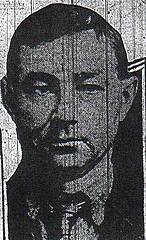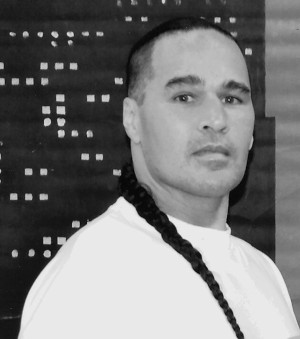Related Research Articles

Bank robbery is the criminal act of stealing from a bank, specifically while bank employees and customers are subjected to force, violence, or a threat of violence. This refers to robbery of a bank branch or teller, as opposed to other bank-owned property, such as a train, armored car, or (historically) stagecoach. It is a federal crime in the United States.

Harry "Pete" Pierpont was a Prohibition era gangster, convicted murderer and bank robber. He was a friend and mentor to John Dillinger.

The 2006 Securitas depot robbery in Tonbridge, England, was the UK's largest cash heist. It began with a kidnapping on the evening of 21 February 2006 and ended in the early hours of 22 February, when seven criminals stole almost £53 million. The gang left behind another £154 million because they did not have the means to transport it.

Edward James Adams was a notorious American criminal and spree killer in the Midwest. He murdered seven people—including three policemen—over a period of around 14 months, and wounded at least a dozen others. At age 34, Adams was surrounded and then killed by police in Wichita, Kansas.
Earl Edwin Austin was an American criminal and bank robber who had been listed on the FBI's "Ten Most Wanted" list during the 1970s.

Morris Lynn Johnson is a Kentucky-born criminal, whose crimes include armed robbery, escape and rescue, bank robbery, and assaulting a police officer. He was briefly listed on the FBI's Ten Most Wanted list in 1976.
Ralph Fults was a Depression-era outlaw and escape artist associated with Raymond Hamilton, Bonnie Parker and Clyde Barrow of the Barrow Gang.

John Paul Chase was an American bank robber and Depression-era outlaw. He was a longtime criminal associate of the Karpis-Barker Gang and most notably Baby Face Nelson who later brought him into the John Dillinger gang. FBI Director J. Edgar Hoover once referred to Chase as "a rat with a patriotic-sounding name". Chase and Nelson continued to rob banks with John Dillinger until Dillinger's death in July 1934. After the death of Nelson in November 1934, Chase fled back to California where he was arrested a month later on December 27, 1934. Chase was sent to Alcatraz where he became one of the longest-serving inmates;.
Ed Davis was an American burglar, bank robber, and Depression-era outlaw. He was particularly active in Oklahoma, referred to by authorities as "The Fox", and frequently teamed with Jim Clark and Frank Sawyer during the early 1930s. Eventually captured in 1934, he was involved in a failed escape attempt from Folsom State Prison, resulting in the deaths of one guard and two inmates, and was executed at San Quentin.
Jim Clark was an American bank robber and Depression-era outlaw. A longtime career criminal in Oklahoma during the 1920s, Clark was associated with Wilbur Underhill, Harvey Bailey and Robert "Big Bob" Brady and remained a public enemy in the state of Kansas until his capture and imprisonment in 1934.

The Holden–Keating Gang was a bank robbing team, led by Thomas James Holden and Francis Lawrence Keating, which was active in the Midwestern United States from 1926 to 1932. Holden was described by a spokesman for the FBI as "a menace to every man, woman, and child in America" and was the first fugitive to be officially listed on the FBI's Top Ten Most Wanted List in 1950.
James Franklin "Frank" Sawyer was an American Depression-era bank robber and prison escapee. An associate of Jim Clark, Ed Davis and other fellow Oklahoma bandits, he was a participant in countless bank robberies throughout Kansas and Oklahoma between 1917 and 1933. He was wrongfully imprisoned for a 1932 bank robbery in Fort Scott, Kansas and spent almost 40 years in prison before he was pardoned by Governor Robert Docking in 1969.

Frederick Grant Dunn (1905–1959) was an American criminal, burglar and bank robber whose career spanned over four decades from 1919 until his mysterious death in 1959. He led a small gang during the 1940s and 1950s, Dunn becoming referred to by the press as "the modern John Dillinger", and whose activities eventually resulted in his being listed on the FBI's Ten Most Wanted in 1958.

Herman Karl Lamm, known as Baron Lamm, was a German-American bank robber. A former Prussian Army soldier who immigrated to the United States, Lamm believed a heist required all the planning of a military operation. He pioneered the concepts of "casing" a bank and developing escape routes before conducting the robbery. Using a meticulous planning system called "The Lamm Technique", he conducted dozens of successful bank robberies from the end of World War I.
Forrest Silva "Woody" Tucker was an American career criminal first imprisoned at age 15 who spent the rest of his life in and out of jail. He is best known as an escape artist, having escaped from prison "18 times successfully and 12 times unsuccessfully", by his own reckoning. The 2018 film The Old Man & the Gun, starring Robert Redford as Tucker, is based on his life.
Wilbur Underhill Jr., often called "Mad Dog" or the "Tri-State Terror", was an American criminal, burglar, bank robber and Depression-era outlaw. He was one of the most wanted bandits in Oklahoma during the 1920s and 1930s and co-led a gang with Harvey Bailey that included many fellow Cookson Hills outlaws including Jim Clark, Ed Davis and Robert "Big Bob" Brady.
George Earl "The Kid" Northern (1903–1936) was a Prohibition-era bank robber and early associate of Harry Pierpont. He was the older brother of Pierpont's girlfriend, Mary Kinder.

The Soldiers of Aryan Culture (SAC), sometimes referred to erroneously as Soldiers of the Aryan Culture or Soldiers of an Aryan Culture, is a large white supremacist prison gang in the United States.

Byron Shane Chubbuck, also known Oso Blanco de Aztlán and popularly referred to as Robin the Hood is a convicted American bank robber and indigenous activist. He has been officially charged with around 20 bank robberies, but Chubbuck himself puts the number closer to 50.
On February 10, 1997, the Seafirst Bank branch of Lakewood, Washington, was robbed of $4,461,681 in cash by Billy Kirkpatrick and Ray Bowman, also known as the Trenchcoat Robbers. An investigation by the Federal Bureau of Investigation and the Internal Revenue Service caught the two, and they were both sent to 15 years in prison in 1999. It is one of the largest robberies in U.S. history.
References
- ↑ Kotlowitz, Alex (July 8, 2002). "The Trenchcoat Robbers". The New Yorker . Retrieved 30 July 2014.
- 1 2 3 Jackman, Tom (November 8, 1998). "Cash Deal Undid Trench Coat Robbers". The Washington Post . Sun-Sentinel. Archived from the original on January 28, 2014. Retrieved 30 July 2014.
- ↑ "Bank robbers face charges after years on the run". lubbockonline.com. November 4, 1998. Retrieved 30 July 2014.
- 1 2 Kotlowitz, Alex (July 8, 2002). "The Trenchcoat Robbers". The New Yorker. alexkotlowitz.com. Retrieved 2 August 2014.
- ↑ https://www.bop.gov/mobile/find_inmate/byname.jsp